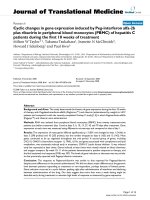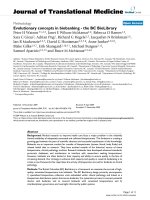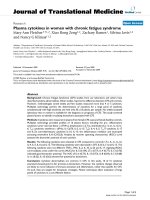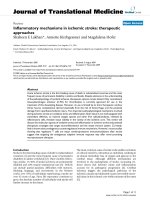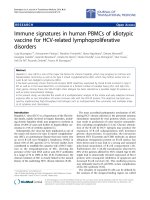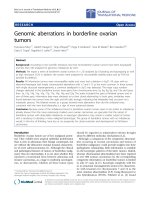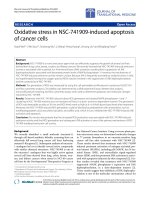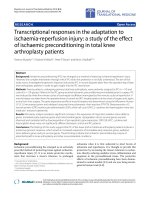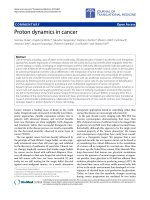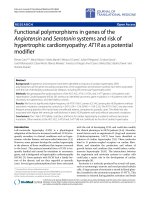Báo cáo hóa học: " Improved coverage in WSNs by exploiting spatial correlation: the two sensor case" pptx
Bạn đang xem bản rút gọn của tài liệu. Xem và tải ngay bản đầy đủ của tài liệu tại đây (654.28 KB, 11 trang )
RESEARC H Open Access
Improved coverage in WSNs by exploiting spatial
correlation: the two sensor case
Michalis Michaelides
*
and Christos G Panayiotou
Abstract
One of the main applications of Wireless Sensor Networks (WSNs) is area monitoring. In such problems, it is
desirable to maximize the area coverage. The main objective of this work is to investigate collaborative detection
schemes at the local sensor level for increasing the area coverage of each sensor and thus increasing the coverage
of the entire network. In this article, we focus on pairs of nodes that are closely spaced and can exchange
information to decide their collective alarm status in a decentralized manner. By exploiting their spatial correlation,
we show that the pair can achieve a larger area coverage than the two individual sensors acting alone. Moreover,
we analyze the performance of different collaborative detection schemes for a pair of sensor nodes and show that
the area coverage achieved by each scheme depends on the distance between the two sensors.
Keywords: Wireless Sensor Networks, area monitoring, coverage, distributed detection, spatial correlation
Introduction
This article investigates a Wireless Sensor Network
(WSN) for monitoring a large area for the presence of
an event source that releases a certain signal or sub-
stance in the environment which is then propagated
over a large area. This sensor network can deal with a
number of environmental monitoring and tracking
applications including acoustic source localization, toxic
source identification and early detection of fires [1-3]. In
this context, a large number of sensor nodes is deployed
in the field and the objective is to maximize the area
coverage
a
. In order to maximize the area coverage o ne
can optimally place the sensor nodes and/or increase
the detection range of the sensors while maintaining a
fixed false alarm probability. This article considers the
latter by investigating different collaboration schemes
between neighboring nodes. For the environmental
monitoring applications, sensor observations are
expected to be highly correlated in the space domain
[4]. In other words, sensors that are located close to
each other are very likely to record “similar” measure-
ments. The objective of this work is to take advantage
of the correlation in order to increase the collective
coverage range of a pair of sensors while maintaining a
fixed false alarm probability.
In a typical scenario, the event source emits a signal
and its energy attenuates uniformly in all directions and
canbemeasuredonlybythesensornodeslocatedin
the vicinity of the source. On the other hand, sensor
nodes that are located far away from the source do not
receive any signal information so their measurements
are based on noise alone. Furthermore, the sensor mea-
surements are spatially correlated based on the distance
from the source and the distance from each other. At
this point, we should emphasize that the fact that only a
small subset of the sensor nodes receives signal energy
information of variable strength based on their location
relative to the source makes the detection problem in
WSNs significantly different than any related work for
radar/sonar applications (see [5,6] and references
therein). In such applications, the system requirements
will specify a system (overall) false alarm rate (P
F
).
Given the expected noise level and the fusion rule at the
fusion center (sink) one can determine the maximum
acceptable false alarm probability of each individual or
pair of sensors (P
f
) which will then determine their cov-
erage range. Traditionally, the sensing coverage of a sen-
sor node has been represented by a disc around the
sensor node location inside which the energy measured
from the event exceede d a threshold [7-12]. In this
* Correspondence:
KIOS Research Center for Intelligent Systems and Networks and Department
of Electrical and Computer Engineering, Uni versity of Cyprus, Nicosia, Cyprus
Michaelides and Panayiotou EURASIP Journal on Advances in Signal Processing 2011, 2011:11
/>© 2011 Michaelides and Panayiotou; licensee Springer. This is an Open Access article distributed under the terms of the Creative
Commons Attribution License ( icenses/by/2.0), which permits unrestricted use, distribution, and
reproduction in any me dium, provided the original work is properly cited.
context each sensor node would employ an energy
detector (ED) to decide whether to become alarmed and
then at the fusion center the decisions from all alarmed
sensor nodes would be combined using a counting rule
to decide the overall detection of the event [13].
In this article, we consider various collaboration
schemes that can be employed by a pair of nodes. A
straightforward solution would be for each sensor
node to use the ED so that each individual node would
determine its alarm status and then the pair would
determine its collective decision using an AND or an
OR rule. Another possibility is for the pair to exchange
all of their measurements and decide its alarmed status
based on the sample covariance. This is referred to as
the covariance detector (CD). In this article, we also
consider a hybrid detection scheme (the enhanced cov-
ariance detector (ECD)) that combines the strengths of
the ED and the CD for closely spaced sensor nodes. By
utilizing two different thresholds, one for each detector
used, the ECD can improve the overall coverage while
attaining the same probability of false alarms as any
individual detector. An important outcome of this
work is that it shows that the area coverage achieved
by each c ollaborative detection scheme depends on the
distance between the two sensors. When the two sen-
sors are located relatively close to each othe r, ECD
achieves better coverage whereas when the t wo sensors
are spaced further apart, the ED with an OR fusion
rule can achieve better results. Therefore, for monitor-
ing applications one can org anize the sensors of the
field into pairs (e.g., closest neighbors) and each pair
will decide its alarm status using the best detection
algorithm given their relative distance. The corner-
stone of this approach is that closel y spaced sensors
can take advantage of the possible correlation in their
measurements to reduce the false alarm probability
and extend their coverage.
In summary, the contribution of this work is that it
investigates collaborative detection schemes between
pairs of closely spaced sensor nodes and shows that
the choice of which scheme to use should depend on
the distance between the nodes. Furthermore, for the
different detection schemes considered in this article,
we provide an in-depth analysis of their performance
both in terms of detection and false alarm probabil-
ities as well as coverage. A shorter version of this
work introducing the different collaborative detection
schemes has appeared in [14]. Our results indicate
that the proposed hybrid detection scheme (the ECD)
combines the strengths of the ED and the CD and
achieves the best coverage for closely spaced sensor
nodes.
The article is organized as follows. In Sect. II, we pre-
sent the model we have adopted and the underlying
assumptions. Then, in Sect. III, we present the details of
the optimal detector (OD), the ED, the CD and the
ECD as they apply to a pair of sensor nodes. Section IV
analyzes the area coverage for each of the detectors.
Section V presents several simulation results. In Section
VI, we review related work in distributed detection, cov-
erage and spatial correlation in sensor networks. We
conclude with Section VII, where we also present plans
for future work.
Signal propagation model
For the remaining of this article we make the following
assumptions:
(1) A set of N sensor nodes (
N
) is uniformly spread
over a rectangular field of area A.Thenodesare
assumed stationary. The position of each node is
denoted by (x
i
, y
i
), i = 1, , N.
(2) The network is connected in the sense that each
node has at least o ne path to the fusion center
(sink).
(3) If present , the source of the event is located at a
position (x
s
, y
s
) inside A. The signal generat ed at the
source location is normally distribute d
N (0, σ
2
S
)
.
The signal energy attenuates uniformly in all direc-
tions from the source and is modeled by a Gaussian
space-time-varying process s(x, y, t). Since only spa-
tial correlation is considered, we assume that the
samples received at ea ch sensor node location are
temporally independent.
All assumptions are quite common and reasonable
for sensor netw orks. Assumption 3 defines a signal
energy model that is appropriate for a variety of pro-
blems where we use a WSN to monitor the environ-
ment, since sensor observations are expected to be
highly correlated in the space domain [4]. Each
observed sample Z
i
,
t
,ofsensornodei at time t is
represented as:
Z
i
,
t
=
S
i
,
t
+ W
i
,t
(1)
i = 1, , N, t = 1, , M,whereM is the number of
measurements taken by a sensor. S
i, t
is the realization
of a space-time-varying process s(x, y, t), i.e., it is the
sample at sensor i located at a position (x
i
, y
i
)attimet.
Furthermore, W
i, t
is a sequence of i.i.d. Gaussian ran-
dom variables with zero mean and variance
σ
2
W
(white
noise).
The random variables S
i, t
model the signal that is
received by the sensors due to the source. Clearly, if no
source is present then S
i, t
≡ 0 for all i, t thus the sensor
nodes measure only noise (W
i, t
). On the other hand, if
a source is present, then the signal energy received by
Michaelides and Panayiotou EURASIP Journal on Advances in Signal Processing 2011, 2011:11
/>Page 2 of 11
sensor i will depend on the distance of t he sensor from
the source. Specifically, we assume that
E[S
i
,
t
]=
0
(2)
E[S
2
i
,
t
]=σ
2
S
C
2
(λ
v
, r
i
)
(3)
E[S
i,t
S
j
,t
]=σ
2
S
C(λ
v
, r
i
)C(λ
v
, r
j
)C(λ
c
, d
i
j
)
(4)
where d
ij
is the Euclidean distance between the sensor
nodes i and j and r
i
is the distance of node i from the
source, i.e.,
r
i
=
(x
i
− x
s
)
2
+(y
i
− y
s
)
2
. Furthermore, |C
(l, r)| is a decreasing function of the distance r suc h
that lim
r®∞
C(l, r) = 0. For the purpos es of this article
we assume that
C
(
λ, r
)
= e
−
r
λ
(5)
l > 0, however, we point out that other functions are
also possible, e.g., see [4]. The constants l
v
and l
c
in (3),
(4) can be chosen according to the physical even t propa-
gation model. The first, reflects the rate at which the sig-
nal e nergy (variance) attenuates as a function of the
radial distance from the source r. The second, reflects the
expected correlation between the signals received
(excluding noise) by two sensor nodes i and j based on
the separation distance between them d
ij
. For a variety of
problems where WSNs are used to monitor the environ-
ment, sensor observations are expected to be highly cor-
relatedinthespacedomain[4].Inotherwords,sensors
that are located close to each other are very like ly to
record “similar” measurements. The signal propagation
model used in this article is chosen to reflect this “simi-
larity”. M easurements of sensors tha t are close to each
other and close to the source are correlated. On the
other hand, sensor nodes that are located far aw ay from
the source do not receive any signal information; so even
if they happen to fall next to each other their measure-
ments are based on uncorrelated noise alone.
Collaborative pairwise detection schemes
For the remaining of this article, we concentrate on a
single pair of sensor nodes that w.l.o.g. are assumed to
be located on the horizontal axis in the middle of the
field A and are placed at a distance d apart (at points
(−
d
2
,0
)
and
d
2
,0
.). Under the modeling assumptions
used in this article, the detection problem can be mathe-
matically described as,
H
0
: z =
w
H
1
: z = s +
w
where
s∼N (0,C
s
,w∼N (0,σ
2
W
I
)
, and s and w are inde-
pendent. The signal covariance matrix C
s
can be calcu-
lated using (2)-(5) as,
C
s
= σ
2
S
e
−
r
1
+ r
2
λ
v
⎛
⎜
⎜
⎜
⎝
e
−
r
1
− r
2
λ
v
e
−
d
λ
c
e
−
d
λ
c
e
−
r
2
− r
1
λ
v
⎞
⎟
⎟
⎟
⎠
.
(6)
For detecting the presence of an event in the field
using the pair of sensors, we investigate two different
categories of collaborative detection schemes. In the
first category, we have classical detection schemes that
employ a single test statistic: the OD, the ED with either
the AND or the OR fusion rules and the CD. In the sec-
ondcategoryweintroduceahybriddetectionscheme
that appropriately fuses the results from two different
test statistics: the ECD. For each detector, one of the
two sensors (referred to as the leader) collects the
required information and computes the test statistic.
Definition 1: Asensoris“alarmed” if the value of the
test statistic
T
(depending on the detection algorithm)
exceeds a pre-determined threshold.
Next, we present the specifics of each detector below
and derive analytical expres sions that approximate their
performance (in terms of probability of false alarm and
detection).
Optimal detector
Assuming the two nodes are synchronized and all signal
measurements are available at the leader, the modeling
assumptions of this article lead to the general Gaussian
detection problem. The test statistic for the OD for this
problem is given in [15] as:
T
OD
=
1
M
M
t
=1
z[t]
T
C
s
(C
s
+ σ
2
W
I)
−1
z[t] γ
o
(7)
where z[t]
T
=[Z
1,t
, Z
2,t
] are the sensor measure-
ments and g
o
is the threshold calculated in a Neyman-
Pearson formulation to achieve a pre-specified prob-
ability of false alarms constrain. The detection perfor-
mance of the OD (also known in the literature as
estimator-correlator or Wiener filter) is in general dif-
ficult to obtain analytically[15].However,foralarge
number of samples M, using the Central Limit Theo-
rem (CLT), the test statistic in (7) has a Gaussian dis-
tribution that depends on the underlying hypothesis.
Under the H
0
hypothesis, the probability of false
alarms is given by
P
f|OD
= Pr{T
OD
γ
o
|H
0
} = Q
γ
o
− μ
0|OD
σ
0
|
OD
(8)
Michaelides and Panayiotou EURASIP Journal on Advances in Signal Processing 2011, 2011:11
/>Page 3 of 11
where
μ
0
|
OD
= σ
2
W
(b
11
+ b
22
)
(9)
σ
2
0|OD
=
2
M
σ
4
W
b
2
11
+ b
2
22
+
1
2
(b
12
+ b
21
)
2
(10)
are the mean and the variance of the OD test statistic
under H
0
and [b
ij
]fori, j = 1, 2 are the entries of the
B
= C
s
(C
s
+ σ
2
W
I)
−
1
matrix in (7). Using the above equa-
tions, the threshold g
o
can be c alculated such that the
pair’s probability of false alarms constrain P
f|OD
= a for
a specific source location and distribution as,
γ
o
= σ
0|
O
D
Q
−1
(α)+μ
0|
OD
(11)
The probability of detection can then be obtained
numerically using this threshold.
The drawback of the OD is that it requires complete
knowledge of the signal distribution (through the matrix
C
s
) and it is thus impractical for the problem under
investigation. Even if we use a grid based exhaustive
search method to detect a source at all possible source
locations on the grid, we still have to assume knowledge
of the signal v ariance
σ
2
S
and calculate a different
threshold for each possible source location.
The OD performance is optimal using a Neyman-
Pearson for mulation [15]. In other words, given a fixed
probability of false alarms, the OD can achieve the
highest detection probability than any other detector
that uses any other test statistic and any other thresh-
old. However, this result only applies to detection
schemes that use a single test statistic. In fact, ECD, the
hybrid detection scheme proposed in this article, under
certain conditions can outperform the OD by fusing
together information from two different test statistics
(see Sect. V).
Energy detector
For the ED each sensor independently decides first its
alarm status based on its own measurements. Then, the
1-bitdecisionsaregatheredattheleaderwherethe
detection decision of the pair is decided using an AND
or an OR fusion strategy. Using the AND fu sion rule,
the pair decides that it has detected the event if both
sensors are alarmed, while using the OR strategy detec-
tion is decided if at least one of the sensor nodes
becomes alarmed.
The test statistic used by each sensor is the sample
variance
b
of the measurements compared to a constant
threshold g
e
,
T
ED
=
1
M
M
t
=1
Z
2
i,t
γ
e
(12)
At this point we should clarify that a different
threshold g
e
applies for each fusion rule. Strictly speak-
ing, the test statistic is c-distributed, however, for large
enough M, the CLT applies and so the distribution of
the test statistic is approximated by a nor mal distribu-
tion which can simplify the computation of the a ppro-
priate threshold g
e
such that the false alarm
requirement is satisfied. Using the CLT, the probabil-
ities of false alarm p
f|ED
and detection p
d|ED
of the ED
for a single node are given by
p
f|ED
= Q
γ
e
− Mσ
2
0|ED
√
2Mσ
2
0
|
ED
(13)
p
d|ED
= Q
γ
e
− M(σ
2
0|ED
+ σ
2
1|ED
)
√
2M(σ
2
0
|
ED
+ σ
2
1
|
ED
)
(14)
where
σ
2
0|ED
=
σ
2
W
M
(15)
σ
2
1|ED
=
σ
2
S
e
−
2
r
λ
v
M
(16)
and
Q(x)=
1
√
2π
∞
x
exp(−
y
2
2
)d
y
is the right-tail
probability of a Gaussian random variable
N
(0, 1) [15].
1) Fusion rules for the ED: Next, we consider the case
where the decisions of the two sensor nodes are c om-
bined. Under H
0
thedecisionsofthetwosensornodes
are independent and the pair’ s probability of false alarm
for the two fusion rules AND(
∧
) and OR(
∧
) are:
P
∧
f
|
ED
= p
2
f
|
ED
(17)
P
∨
f
|
ED
=1− (1 − p
f|ED
)
2
(18)
Using a Neyman-Pearson formulation we set
P
(.)
f
|
ED
=
α
and using (13) we can derive the threshold that each
node in the pair should use depending on the fusion
rule.
γ
∧
e
=
2σ
4
W
M
Q
−1
(
√
α)+σ
2
W
(19)
γ
∨
e
=
2σ
4
W
M
Q
−1
1 −
√
1 − α
+ σ
2
W
(20)
Note that of
√
α 1 −
√
1 − α
for all 0 ≤ a ≤ 1and
since Q
-1
( y) is a decreasing function of y to achieve a
Michaelides and Panayiotou EURASIP Journal on Advances in Signal Processing 2011, 2011:11
/>Page 4 of 11
probability of f alse alarm a,weneedtohave
γ
∧
e
<γ
∨
e
.
In other words, the AND rule requires a smaller thresh-
old than the OR rule. This observation will become sig-
nificant when we study the coverage of the detectors in
Sect. IV.
Under H
1
, the test statistics of the two sensor nodes 1
and 2 for large M become 2 correlated Gaussian ran-
dom variables
T
ED
|
1
and T
ED
|
2
. To derive the system
probability of detection for the ED for the two fusion
rules we f irst make the following observation. The OR
fusion rule can be thought of as max
{T
ED|1
, T
ED|2
} γ
∨
e
while the AND fusion rule is min
{T
ED|1
, T
ED|2
} γ
∧
e
. The exact distribution of the Max
and Min of two correlated Gaussian random variables is
given in [16] which can be used to obtain the probability
of detection for the pair of nodes under the different
fusion rules.
Covariance detector
For the CD, we assume that the two sensor nodes can
synchronize their measurements over the next time
interval. For the synchroniza tion we are assuming a
lightweight scheme like the one proposed in [17] where
a pair-wise synchronization is achieved with only three
messages. Then, the leader node receives the measure-
ments of the other sensor and computes the following
test statistic:
T
CV
=
1
M
M
t
=1
(Z
1,t
− Z
1
) × (Z
2,t
− Z
2
)
γ
c
(21)
where
Z
i
=
1
M
M
t=1
Z
i,
t
. The test statistic used is the
sample covariance of the measurements between the
two sensor nodes compared to a constant threshold g
c
.
Note that (21) exploits the correlation between the mea-
surements of two sensors that are located close to each
other.
For large M, again using the CLT, the test statistic in
(21) has a Gaussian distribution that depends on the
underlying hypothesis:
T
CV
∼
N (0, σ
2
0|CD
), under H
0
N (μ
1|CD
, σ
2
1
|
CD
), under H
1
For the model under investigation,
σ
2
0|CD
=
σ
4
W
M
(22)
μ
1|CD
= σ
2
S
e
−(
r
1
+ r
2
λ
v
+
d
λ
c
)
(23)
while
σ
2
1
|
C
D
is obtained numerically.
Under the H
0
hypothesis, the probability of false
alarms for the pair of sensor nodes 1 and 2, is
given by
P
f|CD
=Pr{T
CV
γ
c
|H
0
} = Q
γ
c
σ
0
|
CD
(24)
where s
0|CD
isgivenby(22).Usingtheaboveequa-
tion, the threshold g
c
can be calculated to attain a prob-
ability of false alarms constrain P
f|CD
= a,
γ
c
=
σ
4
W
M
Q
−1
√
α
(25)
It is worth pointing out that the threshold obtained by
the CD may be much lower (depending on the noise
variance
σ
2
W
) than the one obtained for the ED in the
previous section to attain the same P
f
–compar e the
above equation with (19) and (20). Under H
1
,again
using the CLT, the probability of detection for the pair
of sensor nodes is given as a function of the threshold
g
c
by
P
d|CD
= Pr{T
CV
γ
c
|H
1
}≈Q
γ
c
− μ
1|CD
σ
1
|
CD
(26)
where μ
1|CD
is given by (23) and s
1|CD
is obtained
numerically.
Enhanced covariance detector
The proposed ECD uses two test statistics; the ED test
statistic (12) and the CD test statistic (21) using the fol-
lowing fusion rule.
{T
CD
γ
c
2
}∧{(T
ED|1
γ
∨
e
2
) ∨ (T
ED|2
γ
∨
e
2
)}
.
(27)
In other words, a pair of sensors will become alarmed
only if the sample covariance measured by the pair
exceeds a threshold
γ
c
2
(different than the threshold
used by the CD alone) and if either of the sensors
becomes alarmed using the ED (i.e., if the recorded sam-
ple variance exceeds
γ
∨
e
2
, different from t he correspond-
ing ED threshold). The test statistic is computed by any
one of the two sensor nodes. The two thresholds,
γ
c
2
and
γ
∨
e
2
are computed using
P
∨
f
|
ED
=
√
α
and
P
f
|
CD
=
√
α
for the individual detectors ED and CD, respectively,
using (20) and (25). This ensures that the pair’sprob-
ability of false alarms for the ECD will be
P
f
|
ECD
=
√
α ×
√
α =
α
and we can directly compare its
performance with the other detectors in a Neyman-
Pearson formulation. The performance of the ECD in
terms of probability of detection can be approximated
assuming that the two decisions are independent or can
be obtained through simulation.
Michaelides and Panayiotou EURASIP Journal on Advances in Signal Processing 2011, 2011:11
/>Page 5 of 11
Coverage area analysis
Inthissectionweformallydefinethecoverageareaof
the pair of sensors in terms of the P
f
and the P
d
.We
show that the coverage area shape and size depends on
the underlying fusion rule.
Definition 2: Given the acceptable false alarm prob-
ability for each pair is P
f
= a, “Coverage Area“ denotes
the area around the sensor locations where if a source is
present it will be detected by the pair with probability
P
d
1
2
.
This area is a function of the detection algorithm and
the threshold used. When the test statistic has a Gaus-
sian distribution
∼ N (μ
1
, σ
2
1
)
under the H
1
hypothesis,
the coverage area can also be represented by
P
d
= Q
μ
1
− γ
σ
1
1
2
⇒ μ
1
γ
(28)
where g is the appropriate detection threshold. Note
thatdefiningthecoverageareaas
P
d
1
2
,isjustacon-
vention used to facilitate t he graphical analysis. In thi s
way, for symmetric distributions (e.g., Gaussian), the cov-
erage area shape becomes simply a funct ion of the mean.
Next we investigate the coverage area for each detector.
Energy detector
From (28) and using (14), we can calcu late the coverage
area of a single sensor using the ED which becomes a
disc around the sensor node location with radius R
e
given by
p
d|ED
=
1
2
⇒ σ
2
S
e
−
2
R
e
λ
v
+ σ
2
W
= γ
e
⇒ R
e
=
λ
v
2
ln
σ
2
S
γ
e
− σ
2
W
.
(29)
Note that R
e
is a function of the detection threshold
g
e
. Figure 1 displays p
d|ED
versus the distance from the
source r for different values of the threshold g
e
.From
the figure, it becomes evident that as the threshold g
e
is
increased, the p
d|ED
curve can be approximated by a
step function; p
d|ED
is close to one when the source falls
inside the sensor coverage disc while it sharply falls if
the source is outside. In ord er to achieve a fairly small
false alarm probability, which is desirable in the context
of monitoring applications, it is desirable to select a
threshold such that the probability of detection falls to
zero when the source is at a distance from the sensor;
the larger the threshold the sooner the cutoff appears
and the lower the false alarm probability. Assuming that
p
d|ED
takes the form of the step function (see Figure 1),
then the coverage area of the pair depends on the fusion
rule used. The coverage area is given by the un ion and
intersection between two circles for the AND(
∧
) and OR
(
∧
) fusion rules, respectively, (see Figure 2c). Note from
thefigurethatthediscsfortheAND(
∧
) have a larger
radius than the ones for the OR(
∧
) fusion rule. The rea-
son comes from (19) and (20) where we clearly see that
given P
f
= a we get
γ
∧
e
<γ
∨
e
.
Next we argue that the fusion rule to be used by a
pair depends on the distance d between the two sensors.
Let
A
e
= πR
2
e
denote the coverage area of a single sensor
node where R
e
is given by (29). Also, let
A
∧
e
denote the
combined coverage area of two sensor nodes using the
AND fusion rule and
A
∨
e
the coverage area of two sensor
nodes using the OR fusion rule. As a rgued above,
A
∧
e
> A
∨
e
. When the distance between the two sensors is
zero, both the union and intersection of the circles are
thecirclesthemselves,thusthecoverageareaofthe
AND rule
(A
∧
e
)
is larger. On the other hand, as the
0 100 200 300 400 500 600 700 800 900 100
0
0
0.1
0.2
0.3
0.4
0.5
0.6
0.7
0.8
0.9
1
Distance from the source r
p
d
Increasing threshold
Figure 1 Probability of detection vs. distance from the source r
for a single sensor using the ED for different values of the
threshold g
e
.
$
H
25
$
H
$1'
G
Figure 2 Graphical representation (not drawn to scale) of the
coverage area of two sensor nodes separated by a distance d
when using the ED with different fusion rules. Using the OR(∨)
fusion rule the coverage area is the union of the two smaller circles
(indicated with shaded region) while using the AND(
∧
) the coverage
area becomes the intersection of the two larger circles (indicated
with a grid).
Michaelides and Panayiotou EURASIP Journal on Advances in Signal Processing 2011, 2011:11
/>Page 6 of 11
distance is increased, there is a distance where the two
circles become disjoint and coverage area of the pair
becomes zero, while the coverage area of the pair that
uses the OR rule achieves its maximum equal to
2A
∨
e
.In
fact, there exists a distance
¯
d
where the two fusion rules
have identical performance . For
d
<
¯
d
the AND rule
achieves better coverage whereas
d
>
¯
d
for the OR rule
becomes superior.
Covariance detector
According to (28) and (23) and given the threshold g
c
,
the perimeter of the coverage area by th e two sensors is
given by
σ
2
S
e
−(
r
λ
v
+
d
λ
c
)
= γ
c
.
where r = r
1
+ r
2
. Note that it is necessary that
σ
2
S
>γ
c
since
e
−(
r
λ
v
+
d
λ
c
)
1
for any r, d ≥ 0, l
v
, l
c
>0.
Taking logarithms on both sides and rearranging terms,
r = λ
v
(ln
σ
2
S
γ
c
−
d
λ
c
)=2
a
(30)
Equation 30 is an ellipse with general equation
x
2
a
2
+
y
2
a
2
−
d
2
4
=1
.
(31)
andthereforetheareacoveredbyasensorthatuses
the CD is given by
A
c
= π a
a
2
−
d
2
4
.
(32)
Note that for (32) it is necessary that d<2a.Ifd =0,
i.e., the two sensors are located at the same point, then
the coverage area is a circle with radius a.Alsonote
that the maximum coverage area is achieved when d =
0. In other words, t wo sensors that use the CD can
achieve their maximum coverage when they are located
at exactly the same point.
Enhanced covariance detector
The ECD essentially takes the inter section of the cover-
age areas of two detectors: the CD (ellipse shown in
Figure 3) and the ED using the OR fusion rule (union of
two circles shown in Figure 2). This intersection opera-
tion allows the threshol d of each detector to decrease
and the individual coverage area to increase without
affecting the system probability of false alarms. Since
the coverage areas of the two detectors have similar
shape for closely spaced sensor nodes, taking the inter-
section of the increased indiv idual coverage areas of the
two detectors can improve the coverage area when
using the ECD.
Simulation results
For all subsequent experiments, we use a square field of
500 × 500 with two sensors placed in the middle of the
field separated by a horizontal distance d.Weassume
that the sensor measurements are given by the propaga-
tion model in Sect. II, with
λ
v
= λ
c
= 200, σ
2
W
= σ
2
S
=1
0
and M = 100. The thresholds for all detectors are calcu-
lated using the equations derived in Sect. III, to obtain a
probability of false alarms P
f
= a in a Neyman-Pearson
formulation. To obtain the experimental probability of
detection (P
d
), we take the average over a grid of possi-
ble source locations that cover the entire field. For each
source location we use 500 Monte-Carlo simulations.
For all experiments we use Matlab.
Figure 4 shows the performance of the different detec-
tors for P
f
= 0.01 as we vary the horizontal separation
distance d between the two sensor nodes. From the plot
it is evident that for all detectors, the analytical approxi-
mations for the probability of detection–derived in Sect.
Figure 3 CD coverage area.
0 50 100 150 200
0
0.05
0.1
0.15
0.2
0.25
0.3
0.35
0.4
Se
p
aration distance d between the 2 sensor nodes
P
det
ED (OR) Analytical
ED (AND) Analytical
ECD Analytical
CD Analytical
ED (OR) Experimental
ED (AND) Experimental
ECD Experimental
CD Experimental
OD Experimental
Figure 4 Probability of detecti on vs. separation distance d
between the two sensor nodes for different detectors given P
F
= 0.01.
Michaelides and Panayiotou EURASIP Journal on Advances in Signal Processing 2011, 2011:11
/>Page 7 of 11
III–are very c lose to the experimental results obtained.
The ECD outperforms the other distributed schemes for
d<120 while for greater separation distances d the ED
with the OR fusion rule becomes the best option. The
OD is also shown on the same plot for comparison pur-
poses. To calculate the performance of the OD, we first
used (8-10) to calculate the threshold for each different
source location. Then, the probability of detection was
obtained numerically using these thresholds. It is inter-
esting to note that the hybrid detection scheme ECD
proposed in this article outperforms the OD for d<40.
Remember that the OD refers to a single test statistic
compared to a single threshold but assumes full knowl-
edge of the event location and distribution while ECD
uses two test statistics with two different thresholds.
Next, Figure 5 displays the ROC curves for the differ-
ent pair detectors for two different separation distances
d between the two sensor nodes. For small d,theECD
achieves the better results while for large d the ED with
the OR fusion rule is the best option.
Finally, Figures 6, 7, 8, and 9 show snapshots of the
coverage of the different detectors for the specifie d
values of d for the test scenario displayed in Figure 4.
There are several things to notice from these plots that
are consistent with the analysis in Sect. IV: 1. When the
sensor nodes are very close to each other (see Figure 6),
the coverage area for all detectors is a circle around the
location of the sensor nodes. For this case the hybrid
detector ECD has the best coverage followed by CD that
essentially achieves the optimal performance (OD). It is
also interesting to note that for this case, ED(AND)
achieves slightly better coverage than ED(OR). 2. As the
separation distance between the two sensor nodes is
increased (see Figures 7, 8), the coverage area of the CD
becomes an ellipse around the sensor nodes’ locations
and looks very similar to the one of ED(OR)– this
explains the motivation behind using the E CD. Please
note that while the coverage area of the OD and the ED
(OR) increases, t he coverage area of all other detectors
decreases since they depend o n either covariance infor-
mation–CD, ECD–or simultaneous detection by the two
sensor nodes–ED(AND). 3. When the sensor nodes are
sufficiently apart (see Figure 9) the optimal coverage
area becomes two circles around the individual sensor
nodes’ positions. This is close ly resembled by ED( OR)
which achieves the best coverage out of the distributed
detectors. The other detectors do not perform well for
this case–this is expected because their performance is
based on closely spaced sensor nodes.
Preliminary simulation results with 100 randomly
deployed sensors
In this section we present some preliminary results for
the case where we have 100 randomly deployed sensor
nodes to cover a 1000 × 1000 area. Other than that we
use the simulation parameters of the previous section.
Furthermore, we assume that the fusion center uses a
counting rule, thus it dec ides detection if at least K sen-
sors/pairs become alarmed. Figure 10 displays the ROC
curves for the different detectors. s1 - ED refers to the
case where each sensor node uses the ED and reports
its alarm status to the fusion center which deci des
0 0.1 0.2 0.3 0.4 0.5 0.6 0.7 0.8 0.9 1
0.2
0.3
0.4
0.5
0.6
0.7
0.8
0.9
1
P
det
P
fa
ED (OR)
ED (AND)
ECD
CD
(
a
)
d =1
0 0.1 0.2 0.3 0.4 0.5 0.6 0.7 0.8 0.9
1
0.1
0.2
0.3
0.4
0.5
0.6
0.7
0.8
0.9
1
P
fa
P
det
ED (OR)
ED (AND)
ECD
CD
(
b
)
d = 141
Figure 5 Probability of detection vs. probab ility of false alarms for different detectors given the two sensor nodes are separated by
distance d.
Michaelides and Panayiotou EURASIP Journal on Advances in Signal Processing 2011, 2011:11
/>Page 8 of 11
detection if a t least K =1nodesbecomealarmed.s2-
ED is similar to s1 - ED but the fusion center decide
detection if at least K = 2 nodes are alarmed. For p1-
CD and p1 - ECD, each sensor node utilizes information
from its closest neighbor for computing the test statistics
(
T
C
D
and T
E
CD
, respectively) and the fusion center deci-
des detection if at least K = 1 pairs become alarmed.
From the plot it becomes evident, that utilizing colla-
borative local detect ion schemes (ECD) can significantly
improve the coverage of the WSN especially for small
system probabilities of false alarm P
F
by exploiting sen-
sor nodes that happen to fall close to each other. Redu-
cing the false alarm rate can preserve valuable energy
and extend the lifetime of our WSN while achieving the
required coverage performance. We plan to investigate
this further as part of our future work.
Related work
In this section we review related work from the areas of
distributed detection, area coverage in the context of
WSN.
A. Distributed detection
Distributed detection using multiple sensors and optimal
fusion rules has been extensively investigated for radar
and sonar applications (see [5,6] and references therein).
The objective in most studies is to develop computa-
tionally efficient algorithmsatthesensorsandatthe
fusion center. Optimality is usually studied under the
Neyman-Pearson and Bayesian detection criteria [15,18].
Both of these formulations, however, require complete
or partial knowledge of the joint densities (pdf) of the
observations at the sensor nodes given the hypothesis.
For conditionally independent observations, optimum
fusion rules have been derived in [19,20]. In large-scale
WSNs, however, the signal generated by the event to be
detected has unknown strength and varies spatially mak-
ing sensor observations location-dependent and not
identically distributed. Without the conditional indepen-
dence assumption there is no guarantee that optimal
decision rules can be derived in term s of thresholds for
the likelihood ratio because the optimal solution is
mathematically intractable (NP-hard) [21]. Fusion rules
for correlated observations have been studied in [22- 24].
They derive the optimum strategy at the fusion center
when the local sensor performances in terms of the
probability of detection, the probability of false alarm
and the correlation between their local decisions are
given. For the WSN under investigation, however, both,
the local sensor performance and the correlation
between their measurements are unknown and can
change dynamically with the location of the event, mak-
ing it infeasible in most cases to obtain this information
at the fusion center. Consequently, one needs to resort
to suboptimal schemes and heuristics to achieve the
desired objectives and the optimal decision rule for
detection should be determined at the sensor node level
sometimes even before deployment [25].
B. Coverage in WSN
Coverage has been extensively studied for sensor net-
works in the last few years using mostly computational
0 50 100 150 200 250 300 350 400 450 500
0
50
100
150
200
250
300
350
400
450
500
0.1
0.2
0.3
0.4
0.5
0.6
0.7
0.8
0.9
(
a
)
OD
0 50 100 150 200 250 300 350 400 450 500
0
50
100
150
200
250
300
350
400
450
500
0.1
0.2
0.3
0.4
0.5
0.6
0.7
0.8
0.9
(
b
)
ED
(
AND
)
0 50 100 150 200 250 300 350 400 450 500
0
50
100
150
200
250
300
350
400
450
500
0.1
0.2
0.3
0.4
0.5
0.6
0.7
0.8
0.9
(
c
)
ED
(
OR
)
0 50 100 150 200 250 300 350 400 450 500
0
50
100
150
200
250
300
350
400
450
500
0.1
0.2
0.3
0.4
0.5
0.6
0.7
0.8
0.9
(
d
)
CD
0 50 100 150 200 250 300 350 400 450 500
0
50
100
150
200
250
300
350
400
450
500
0.1
0.2
0.3
0.
4
0.5
0.6
0.
7
0.8
0.9
(
e
)
ECD
Figure 6 Detection snapshots between two sensor nodes separated by d =1m.
0 50 100 150 200 250 300 350 400 450 500
0
50
100
150
200
250
300
350
400
450
500
0.1
0.2
0.3
0.4
0.5
0.6
0.7
0.8
0
.
9
(
a
)
OD
0 50 100 150 200 250 300 350 400 450 500
0
50
100
150
200
250
300
350
400
450
500
0.1
0.2
0.3
0.4
0.5
0.6
0.7
0.8
0
.
9
(
b
)
ED
(
AND
)
0 50 100 150 200 250 300 350 400 450 500
0
50
100
150
200
250
300
350
400
450
500
(
c
)
ED
(
OR
)
0 50 100 150 200 250 300 350 400 450 500
0
50
100
150
200
250
300
350
400
450
500
0.1
0.2
0.3
0.4
0.5
0.6
0.7
0.8
0
.
9
(
d
)
CD
0 50 100 150 200 250 300 350 400 450 500
0
50
100
150
200
250
300
350
400
450
500
0.1
0.2
0.3
0.
4
0.5
0.6
0.
7
0.8
0
.
9
(
e
)
ECD
Figure 7 Detection snapshots between two sensor nodes separated by d =61m.
Michaelides and Panayiotou EURASIP Journal on Advances in Signal Processing 2011, 2011:11
/>Page 9 of 11
geometry techniques for developing algorithms for
worst-best case coverage [7], exposure [8], or to deter-
mine whether an area is sufficiently k-covered [9]. Sche-
duling schemes have also been investigated in the
literature for turning off some nodes while st ill preser-
ving a complete coverage of the monitored area [26].
Most of the aforementioned work, however, assumes
that the sensing coverage of a sensor node can be repre-
sented by a uniform disc inside which an event is always
detected. There have also been a few attempts in the lit-
erature to deal with coverage in a probabilistic way by
adding noise to the sensor measureme nts and consider-
ing the tradeoff involving the probability of false alarms
[10-12]. They all assume i.i.d. observations between the
sensor nodes, however, and do not consider the effects
of spatial correlation.
Spatial correlation in WSN
In [4] the authors develop a theoretical framework to
model the spatial and temporal correlations in a WSN
and use it for designing efficient communication proto-
cols but they do not address the problem of detection.
The authors of [27] develop a decision fusion Bayesian
framework for detectin g and correcting sensor measure-
ment faults in event region detection by exploiting the
fact that measurement errors are uncorrelated while
environmental conditions are spatially correlated. Spatial
correlation in their work is only reflected by the fact
that sensor nodes lie inside the event region they aim to
detect. We additionally model the spatial correlation in
the actual measurements t hat the sensor nodes get
based on the distance from the event source and the
distance from each other.
Conclusions and future work
In this article we investigate distributed detection st rate-
gies for improving the coverage (det ection performance)
of two sensor nodes as we vary the separation distance
between them. For closely spaced sensor nodes the pro-
posed ECD can significantly improve the covera ge while
attaining the same probability of false alarms as any other
single distributed detection scheme. For sensor nodes
that are further apart using the ED (with an OR fusion
rule between the two sensor nodes) achieves the best
coverage out of the distributed detector schemes tested.
For our future work we plan to extend these results to
a randomly deployed WSN for detecting the presence of
an event source. We plan to use a hybrid detection
scheme where each sensor node independently decides
which detector to employ based on the distance from its
closest neighbor. Based on our current resul ts we believe
that this can improve significantly the overall coverage of
the WSN, since it is often the case in random deploy-
ments that sensor nodes fall very close to each other.
Endnotes
a
For the purposes of this article, coverage is the prob-
ability of detecting the event averaged over the entire
field under observation subject to a fixed probability of
false ala rms in a Neyman-Pearson formulation. In other
words, coverage can be thought of as the spatial prob-
ability of detection, or the percentage of the area under
0 50 100 150 200 250 300 350 400 450 500
0
50
100
150
200
250
300
350
400
450
500
0.1
0.2
0.3
0.4
0.5
0.6
0.7
0.8
0
.
9
(
a
)
OD
0 50 100 150 200 250 300 350 400 450 500
0
50
100
150
200
250
300
350
400
450
500
0.1
0.2
0.3
0.4
0.5
0.6
0.7
0.8
0
.
9
(
b
)
ED
(
AND
)
0 50 100 150 200 250 300 350 400 450 500
0
50
100
150
200
250
300
350
400
450
500
0.1
0.2
0.3
0.4
0.5
0.6
0.7
0.8
0
.
9
(
c
)
ED
(
OR
)
0 50 100 150 200 250 300 350 400 450 500
0
50
100
150
200
250
300
350
400
450
500
0.1
0.2
0.3
0.4
0.5
0.6
0
.
7
(
d
)
CD
0 50 100 150 200 250 300 350 400 450 500
0
50
100
150
200
250
300
350
400
450
500
0.1
0.2
0.3
0.4
0.5
0.6
0.7
0.8
0
.
9
(
e
)
ECD
Figure 8 Detection snapshots between two sensor nodes separated by d = 121 m.
0 50 100 150 200 250 300 350 400 450 500
0
50
100
150
200
250
300
350
400
450
500
0.1
0.2
0.3
0.4
0.5
0.6
0.7
0.8
0
.
9
(
a
)
OD
0 50 100 150 200 250 300 350 400 450 500
0
50
100
150
200
250
300
350
400
450
500
0.1
0.2
0.3
0.4
0.5
0.6
0.7
0
.
8
(
b
)
ED
(
AND
)
0 50 100 150 200 250 300 350 400 450 500
0
50
100
150
200
250
300
350
400
450
500
0.1
0.2
0.3
0.4
0.5
0.6
0.7
0.8
0
.
9
(
c
)
ED
(
OR
)
0 50 100 150 200 250 300 350 400 450 500
0
50
100
150
200
250
300
350
400
450
500
0.05
0.1
0.15
0.2
0.25
0.3
0
.
35
(
d
)
CD
0 50 100 150 200 250 300 350 400 450 500
0
50
100
150
200
250
300
350
400
450
500
0.1
0.2
0.3
0.4
0.5
0.6
0
.
7
(
e
)
ECD
Figure 9 Detection snapshots between two sensor nodes separated by d = 181 m.
Michaelides and Panayiotou EURASIP Journal on Advances in Signal Processing 2011, 2011:11
/>Page 10 of 11
observation where detection will happen with high
enough probability.
b
Note that the unbiased estimator of the variance is
given by
1
M
−
1
M
t=1
Z
2
i,
t
but for large M the difference
between the two becomes insignificant.
c
Note that due to the difference of the actual p
d|ED
from the step function during the transition from one to
zero (see F igure 1) the coverage area approximation in
Figure 2 is less accurate near the areas where the two
discs intersect. For those situations, the result obtained
from the intersecti on of the two circles (AND)overesti-
mates the true coverage while the result obtained from
the union (OR) underestimates the actual coverage area.
Nevertheless, for the calculation of the total coverage
area this graphical representation method provides a
reasonably accurate approximation.
Abbreviations
CLT: Central Limit Theorem; CD: covariance detector; ED: energy detector;
ECD: enhanced covariance detector; OD: optimal detector; WSN: Wireless
Sensor Network.
Acknowledgements
This work is partly supported by the Cyprus Research Promotion Foundation,
the European Regional Development Fund and the Government of Cyprus.
Competing interests
The authors declare that they have no competing interests.
Received: 7 December 2010 Accepted: 10 June 2011
Published: 10 June 2011
References
1. I Akyildiz, W Su, Y Sankarasubramaniam, E Cayirci, A survey on sensor
networks. IEEE Communications Magazine, 40(8), 102–114, Aug. 2002
2. F Zhao, L Guibas, Wireless Sensor Networks: An Information Processing
Approach. (San Francisco, CA: Morgan Kaufmann, 2004)
3. C Chong, S Kumar, Sensor networks: Evolution, opportunities, and
challenges. Proceedings of the IEEE. 91(8), 1247–1256, Aug. 2003
4. M Vuran, O Akan, I Akyildiz, Spatio-temporal correlation: theory and
applications for wireless sensor networks. Computer Networks, 45, 245–259,
March 2004
5. R Viswanathan, P Varshney, Distributed detection with multiple sensors: Part
I-fundamentals. Proceedings of the IEEE, 85(1), 54–63, Jan. 1997
6. R Blum, S Kassam, V Poor, Distributed detection with multiple sensors: Part
II-advanced topics. Proceedings of the IEEE, 85(1), 64–79, Jan. 1997
7. S Meguerdichian, F Koushanfar, M Potkonjak, M Srivastava, Coverage
problems in wireless ad-hoc sensor networks, in INFOCOM, 1380–1387
(2001)
8. S Meguerdichian, G Koushanfar, G Qu, M Potkonjak, Exposure in wireless
ad-hoc sensor networks, in MOBICOM, 139–150 (2001)
9. C Huang, Y Tseng, The coverage problem in a wireless sensor network.
MONET, 10(4), 519–528 (2005)
10. V Phipatanasuphorn, P Ramanathan, Vulnerability of sensor networks to
unauthorized traversal and monitoring, IEEE Transactions on Computers,
53(3), 364–369, March 2004
11. N Ahmed, S Kanhere, S Jha, Probabilistic coverage in wireless sensor
networks, in IEEE Local Computer Networks, 672–679 (2005)
12. S Adlakha, M Srivastava, Critical density thresholds for coverage in wireless
sensor networks. in IEEE Wireless Communications and Networking
Conference (WCNC ‘03), March 2003
13. R Niu, P Varshney, M Moore, D Klamer, Decision fusion in a wireless sensor
network with a large number of sensors. in 7th IEEE International Conference
on Information Fusion (ICIF’04), Stockholm, Sweden, June 2004
14. MP Michaelides, CG Panayiotou, Collaborative pairwise detection schemes
for improving coverage in WSNs, in IEEE GLOBECOM 2009, Nov. 2009
15. SM Kay, Fundamentals of Statistical Signal Processing: Detection Theory (New
Jersey: Prentice Hall PTR, 1993)
16. S Nadarajah, S Kotz, Exact distribution of the max/min of two gaussian
random variables. IEEE Transactions on VLSI Systems, 16(2), 210–212, Feb.
2008
17. J Greunen, J Rabaey, Lightweight time synchronization for sensor networks.
in 2nd ACM international conference on Wireless sensor networks and
applications (WSNA’03)
, Sep. 2003
18. H Van Trees, Detection, Estimation and Modulation Theory (New York: John
Wiley and Sons Inc., 2001)
19. PK Varshney, Distributed Detection and Data Fusion (New York: Springer,
1997)
20. Z Chair, P Varshney, Optimal data fusion in multiple sensor detection
systems. IEEE Transactions on Aerospace and Electronic Systems, 22(1),
98–101, Jan. 1986
21. J Tsitsiklis, M Athans, On the complexity of decentralized decision making
and detection problems. IEEE Transactions on Automatic Control, 30(5),
440–446, May 1985
22. P Willett, P Swaszek, R Blum, The good, bad, and ugly: distributed detection
of a known signal in dependent gaussian noise. IEEE Transactions on Signal
Processing, 48, 3266–3279, Dec. 2000
23. E Drakopoulos, C Lee, Optimal multisensor fusion of correlated local
decisions. IEEE Transactions on Aerospace and Electronic Systems, 27(4),
593–606, July 1991
24. M Kam, Q Zhu, S Gray, Optimal data fusion of correlated local decisions in
multiple sensor detection systems. IEEE Transactions on Aerospace and
Electronic Systems, 28(3), 916–920, July 1992
25. Y Sung, L Tong, A Swami, Asymptotic locally optimal detector for large-
scale sensor networks under the poisson regime. IEEE Transactions on
Signal Processing, 53(6), 2005–2017, March 2005
26. D Tian, N Georganas, A coverage-preserving node scheduling scheme for
large wireless sensor networks, in First ACM Workshop on Wireless Sensor
Networks and Applications, (2002)
27. B Krishnamachari, S Iyengar, Distributed bayesian algorithms for fault-
tolerant event region detection in wireless sensor networks. IEEE
Transactions on Computers, 53(3), 241–250, March 2004
doi:10.1186/1687-6180-2011-11
Cite this article as: Michaelides and Panayiotou: Improved coverage in
WSNs by exploiting spatial correlation: the two sensor case. EURASIP
Journal on Advances in Signal Processing 2011 2011:11.
0 0.1 0.2 0.3 0.4 0.5 0.6 0.7 0.8 0.9
1
0.65
0.7
0.75
0.8
0.85
0.9
0.95
1
P
F
P
D
s1−ED
s2−ED
p1−CD
p1−ECD
Figure 10 ROC plots for different detectors for 100 randomly
deployed sensor nodes.
Michaelides and Panayiotou EURASIP Journal on Advances in Signal Processing 2011, 2011:11
/>Page 11 of 11
